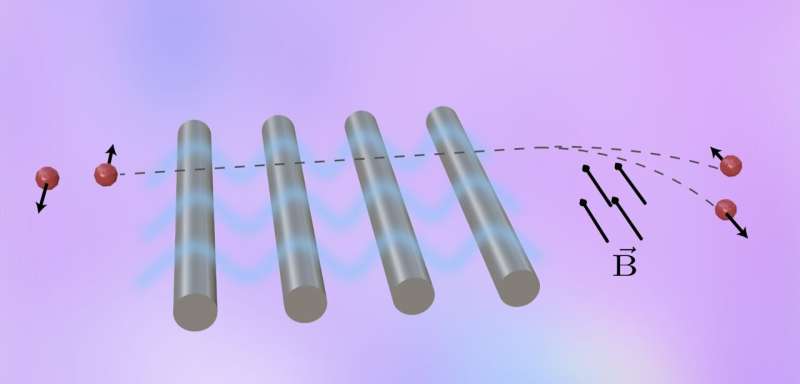Polarizing Free Electrons Using Optical Techniques in a Lab Environment.

June 2, 2023 feature
This article has been reviewed according to Science X's editorial process and policies. Editors have highlighted the following attributes while ensuring the content's credibility:
- fact-checked
- peer-reviewed publication
- trusted source
- proofread
by Ingrid Fadelli , Phys.org
Polarized electrons are electrons that have a preferred orientation or spins preferentially oriented in a specific direction. The realization of these electrons has notable implications for physics research, as it can pave the way for creating promising materials and enabling new experiments.
Researchers at East China Normal University and Henan Academy of Sciences recently introduced a new method to polarize free electrons in a laboratory setting using near-field optical techniques. This approach involves the application of light beams from an optical device positioned close to a sample. Their paper, published in Physical Review Letters, could open interesting new possibilities for high-energy physics, quantum technology development, and materials science.
"The initial idea for this study took root two years ago while I was a postdoctoral researcher in Prof. Francisco Javier Garcia de Abajo's group, renowned for their theoretical work on optical excitations in electron beams," Deng Pan, one of the researchers who carried out the study, told Phys.org. "Since then, the field of photon-induced near-field electron microscopy (PINEM) has gained momentum, emerging as a prominent topic in electron microscopy."
PINEM is a promising microscopy technique that could allow researchers to manipulate the quantum properties of electrons, potentially unveiling new quantum computing mechanisms that rely on free electrons. Previous works primarily focused on using this technique to manipulate the orbitals and momenta of electrons. In their study, Pan and his colleague Hongxing Xu set out to explore its potential use for polarizing free electrons.
"I began to question whether a similar approach could be employed to alter the spin state of electrons or even polarize electron beams," Pan said. "Engaging in discussions with several experts in electron beam theory, most of them believed such an effect to be undetectable given that the magnetic field within the electromagnetic field is significantly weaker than the electric field component. Consequently, it was both surprising and unexpected that my calculations ultimately demonstrated the substantial electron polarization effect within the optical near-field."
The optical method introduced by Pan and Xu draws inspiration from PINEM, as it is based on a similar approach. The researchers used a nanowire array (i.e., a periodic nanostructure) with a carefully designed lattice constant. Their design ensured a near-field match between the input electron velocity and the structure, ensuring a strong interaction between them.
"There is a fundamental difference between my proposal and the PINEM scheme," Pan explained. "The PINEM effect is induced by the electric field component parallel to the electron beam. In contrast, we utilized a transverse electric (TE) near-field, which only possesses the electric field perpendicular to the electron beam. Why did we opt for this TE near-field? The answer is closely linked to another fascinating topic in nanophotonics known as transverse spin angular momentum or spin-orbit interaction in optical near-fields."
The TE near-field applied by the researchers has a circularly polarized magnetic field. As a result, it can be used to manipulate the spins of electrons, just as other fields can be used to control quantum spins.
"A spin electron beam proves to be an invaluable tool in studying magnetic materials and high-energy physics, among other areas," Pan said. "Our research also sheds light on the realization that, although weaker in comparison to the electric field component, the magnetic field component in the optical near-field can be leveraged to achieve unforeseen outcomes."
Pan and Xu are among the first to introduce a reliable optical method to prepare spin electrons in a laboratory environment. In the future, their approach could be adapted and used by other research teams to create spin-polarized electron beams, while potentially also inspiring the development of new quantum computing approaches that leverage both the spins of electrons and photons.
'With the direction provided by this work, there is still an extensive theoretical space to explore, such as the potential for quantum information processing combining electron and photon spins,' Pan added. 'However, I believe the most crucial aspect is the experimental demonstration of the proposal outlined in this study. I have already discussed this work with several experimentalists, and they have expressed optimism regarding the feasibility of achieving our results in experiments.'
Journal information: Physical Review Letters
© 2023 Science X Network




